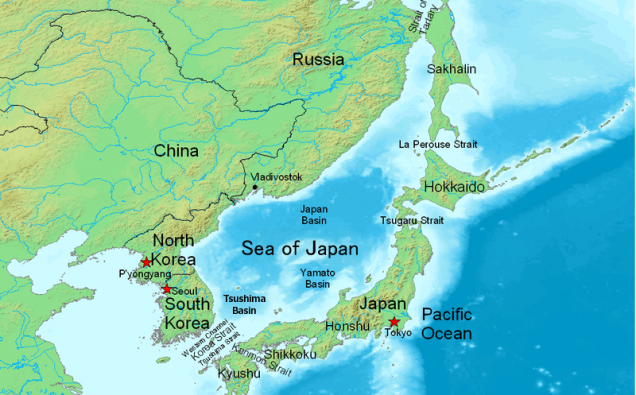
Featured Image By Sea of Japan Map.png: Chris 73 derivative work via Wikimedia Commons
In President Trump’s young administration most of the attention in foreign affairs so far has focused on Russia, the US role in the NATO alliance, trade with China, and ways of dealing with the flow of immigrants into the United States. At the heart of that last debate has been the perceived threat posed by international terrorism in general, and the Islamic State – ISIS – in particular.
However, the first major international crisis facing the Trump White House may come from another source of tension – one that literally rocketed into view in mid-February when North Korea launched a solid-fuel ballistic missile from a hard-to-detect mobile platform, arcing several hundred miles into the Sea of Japan. The missile was unarmed, but was thought to be fully capable of carrying a small nuclear weapon. It’s estimated that North Korea has only a few armed nuclear devices – but also that it has enough weapons-grade material to make up to two dozen nuclear warheads.
The launch in mid-February was the latest test of a delivery system that has been in development at least since the 1990s. North Korea’s clear intent to become a member of the world’s exclusive club of nuclear powers has prompted recent US Presidents to mount diplomatic initiatives and impose sanctions aimed at curbing Pyongyang’s efforts.
Despite such pressure, North Korea has conducted increasingly powerful nuclear tests over the past decade, the last in September showing a blast of 10 kilotons on seismometers in South Korea. Weeks later, in a speech on New Year’s Day, North Korean leader Kim Jong-un said that his government had reached the “final stage” in its preparations for testing its intercontinental ballistic missile capability “to cope with the imperialists’ nuclear war threats”. Mr. Trump, then President-elect, took to Twitter to say that Pyongyang was developing a “nuclear weapon capable of reaching parts of the U.S.” He added, “It won’t happen!”
These blunt exchanges – along with Pyongyang’s missile test and Trump’s withdrawal of the United States from the Trans-Pacific Partnership – have raised East Asian anxieties about threats to the stability of the region. The U.S. acted in early February to reassure Asian allies by sending Defense Secretary James Mattis to Seoul, and hosting Japanese Prime Minister Shinzo Abe at Trump’s estate in Florida. In a joint statement President Trump and Prime Minister Abe urging Pyongyang “to abandon its nuclear and ballistic missile programs and not take any further provocative actions.”
Days later, at a lengthy White House news conference, President Trump, when asked about North Korea’s missile test, said simply, “we’ll take care of it, folks, we’re going to take care of it all.” This was followed by published reports of possible talks in the US between US and North Korean representatives. If that happens it would be the first such contact in more than five years.
The deciding factor in the midst of this tension is likely to be China, North Korea’s longtime mentor and benefactor. Beijing has supported the North since the outbreak of the Korean War in 1950, and for the past 25 years – since the collapse of the Soviet Union – has been Pyongyang’s only consistent partner in the international community. Chinese economic support has been critical for the North, and has also enabled Beijing to restrain Pyongyang from taking destabilizing actions in the region. The U.S. and its allies in Asia have pressured Chinese leaders to push North Korea further in limiting its nuclear weapons program.
Tension in the relationship between the two communist countries has gradually increased in recent years – but has taken a significant jump with the suspected assassination of Kim Jong-un’s half-brother, Kim Jong-nam, who was attacked and poisoned at an airport in Malaysia. After being ousted from North Korea’s line of succession by his younger brother Kim Jong-un five years ago, Kim Jong-nam had lived in China – and if his murder is traced back to Pyongyang, the Chinese government may be embarrassed into taking strong action. As an early sign of its displeasure, China has cut off purchases of North Korean coal until the end of the year. This severs a major financial pipeline for an already-staggering North Korean economy, and indicates China may no longer be willing to support an increasingly unreliable regime.
In the meantime, the Trump administration monitors developments in the region and plans its strategies for dealing with North Korea. It is hardly a coincidence that the first foreign trip by the new Secretary of Defense was to Seoul, and talks with leaders of the South Korean government – who, like their counterparts for the last 65 years, keep a close eye on the regime to the North.
At the end of his visit, Secretary Mattis noted the North Korean nuclear program and said any use by Pyongyang of nuclear weapons would draw an “effective and overwhelming” US response. Asked by reporters if that meant the US would use its own nuclear arsenal, the Secretary paused and said, “the response would be overwhelming.”

















